Spondylosis in dogs is a common condition often seen in older pets. Integrative veterinarian Dr. Julie Buzby describes risk factors, symptoms, diagnosis, and treatment options for spondylosis in dogs. By knowing what to watch for and what to do if spondylosis develops, you will help your senior dog continue to thrive.
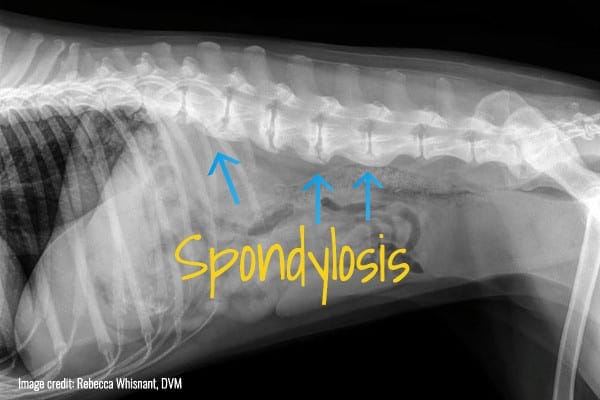
If your dog has been diagnosed with spondylosis, you may be wondering what the future holds. Although X-rays may look dramatic and scary, this condition affects a lot of my senior patients. In this article, we’ll explore what spondylosis is, as well as its causes, symptoms, and risk factors. We’ll also take a look at how vets diagnose this condition, and explore treatment options that have the potential to make a big difference in your dog’s quality of life.
What is spondylosis in dogs?
Spondylosis (spondylosis deformans) is a degenerative condition that affects a dog’s vertebrae—the bones that make up the spinal column and protect the spinal cord. A dog with spondylosis deformans develops bone spurs, also called osteophytes, on the edges of the vertebrae. In some cases, spondylosis is considered a normal part of aging for older dogs.
Dogs with spondylosis often do not show any obvious outward symptoms at all. However, I do believe dogs sometimes display subtle signs of pain and “restriction” of movement related to spondylosis.
How does spondylosis occur?
In order to better understand how spondylosis in dogs occurs, it helps to know a little bit about the anatomy of a dog’s spine.
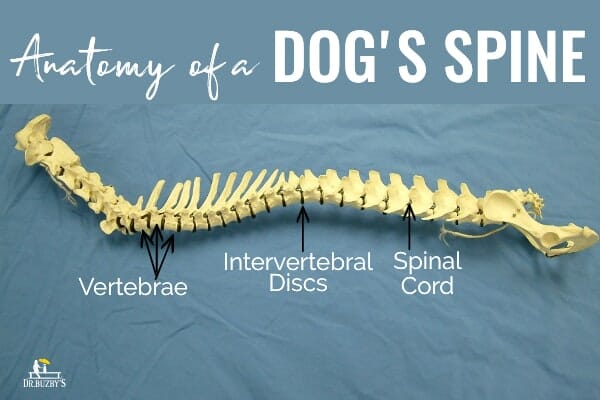
Just like in humans, your dog’s spinal cord is a large bundle of nerves that connects to the base of the brain and runs down the neck and back. The spinal cord has nerve roots that send signals from the brain to the rest of the body. Without the spinal cord, dogs wouldn’t be able to walk or perform their everyday tasks.
Bony vertebrae encase the spinal cord to protect this essential part of the nervous system. Spaces between the vertebrae, which help maintain the back’s flexibility, are cushioned by intervertebral discs—small, soft pads that act as shock absorbers for the spine.
Knowing how to keep your dog’s spine healthy can prolong his or her ability to live and move comfortably.
What causes spondylosis in dogs?
For the most part, the cause of spondylosis in dogs is simply a result of normal wear and tear on the ligaments that connect the intervertebral discs to the ends of the vertebrae. As stress and strain cause microtears in the fibers that make up those ligaments, the body tries to compensate by laying down new bone (bone spurs) on the ends of the vertebrae.
Bridging spondylosis in dogs
As this condition progresses, bony spurs of spondylosis deformans can grow large enough that they touch neighboring spurs and form a “bridge” between vertebrae. This is known as bridging spondylosis. These bony bridges typically form along the thoracolumbar spine, most commonly in the lumbar spine over the lower back.
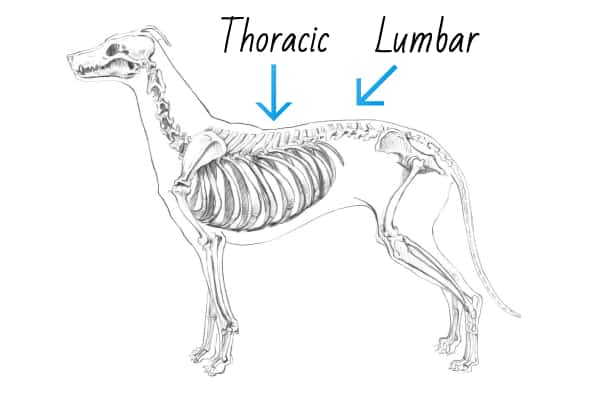
What are the risk factors for spondylosis in dogs?
Spondylosis can affect any middle-aged to older dog. Generally, in most dogs, changes may occur by age 10. Although it was previously thought to be more prevalent in large breed dogs, spondylosis can develop in any breed. As explained in an article from the National Library of Medicine (NIH), it is commonly seen in Boxers, which suggests there may be a genetic predisposition.
Any physical insult to the joints of the spine increases the risk of developing spondylosis. For example, if a dog suffers a traumatic injury that compresses the intervertebral disc spaces, the resulting joint instability predisposes bone spur development in this area.
Similarly, a dog with intervertebral disc disease is likely to develop spondylosis in the affected area since the diseased discs impact stability in those joints.
Essentially, spondylosis is the body’s attempt to protect the weakened joint or joints of the spine by laying down extra bone to stabilize them.
What are the symptoms of spondylosis in senior dogs?
As mentioned above, in most cases, dogs with spondylosis don’t show any outward symptoms. The classic changes in the backbone that we see with spondylosis are not usually responsible for evident pain or lameness. Rather, the condition is most often found incidentally while diagnosing another health condition.
The unique X-ray (radiograph) below perfectly illustrates how spondylosis in dogs is often diagnosed. My colleague, Dr. Jaime Wright Carroll, saw this patient not for back problems, but for gastrointestinal distress.
Abdominal X-rays revealed Dr. Carroll’s patient not only had gastric dilatation and volvulus (GDV), also known as bloat in dogs, but also had two unexpected incidental findings.
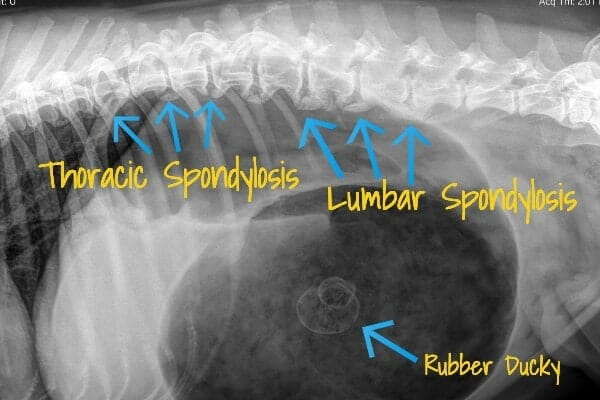
Along with bloat, Dr. Carroll found spondylosis deformans in the dog’s spine. If you look closely at the X-ray above, you’ll see the telltale bone spur “bridges.” She also found a surprise foreign body in the dog’s stomach—a rubber ducky! This pup headed in for emergency surgery to address the GDV and remove the ducky ASAP.
3 symptoms of spondylosis in dogs
Your dog may or may not display symptoms from this “remodeling” of the vertebrae. Severe changes of the vertebrae can potentially put pressure on the spinal canal, resulting in back pain.
Here are three signs of spondylosis to watch for on behalf of your senior dog:
1. Changes in walk
Instead of smoothly swaying from side to side, you may see your dog’s back stiffen and fail to move freely. A stiff gait is not just a sign of leg pain, but can be a common symptom of a sore back. Your vet will perform a physical exam to localize pain if your dog has changes in gait.
2. Change in movement
Your dog’s back may seem rigid, and they may avoid ambitious movements like jumping up or rolling over. You may notice your dog reluctant to turn his head from side to side, or having difficulty maneuvering to reach certain parts of the body.
3. Change in comfort level
If your dog’s bone spur grows large enough to pinch the delicate nerve roots along the spinal cord, he may show signs of pain in dogs and be very sensitive to touch along his back. Some dogs will whine, yelp, or even snap if painful areas of the back are touched.
How does a vet diagnose spondylosis in senior dogs?
Vets use X-rays of the spine to diagnose spondylosis deformans in dogs since the distinctive bone spurs of spondylosis generally show up readily on X-rays. If your vet suspects damage to the spinal cord or inflammation of the nerves, he or she may also recommend advanced imaging. Magnetic resonance imaging (MRI) or CT scan can rule out other issues and ensure appropriate treatment.
The X-ray below confirms a diagnosis of spondylosis for this dog.
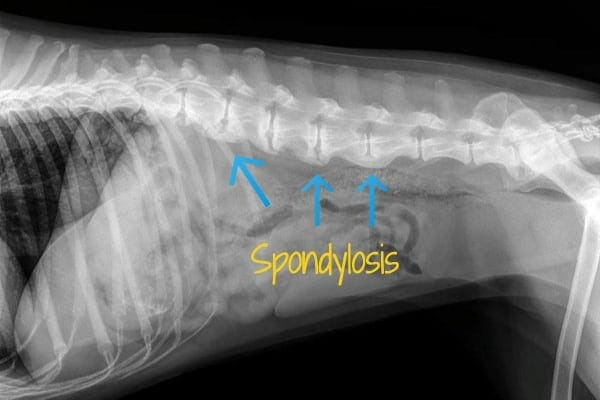
Photo credit: Rebecca Whisnant, DVM
How do you treat spondylosis in dogs?
If your dog has spondylosis but isn’t experiencing pain or discomfort, he or she may not need treatment right away—or ever! But you and your vet may want to discuss adding a joint supplement for dogs to protect those joints from further degeneration.
1. Supplements to help slow the development of spondylosis
Ingredients like glucosamine and chondroitin help keep canine joints flexible and healthy. Therefore, supplements may be helpful in slowing the development of spondylosis.
If you’re trying to find the best supplement for joint pain in dogs, my go-to product recommendation for protecting the health of the joints between the vertebrae is Encore Mobility™ with green lipped mussel and New Zealand deer velvet.
In very rare cases, surgery may be necessary to remove spurs that are causing spinal cord compression. In this unlikely scenario, your vet will likely refer you to a veterinary neurologist or surgeon.
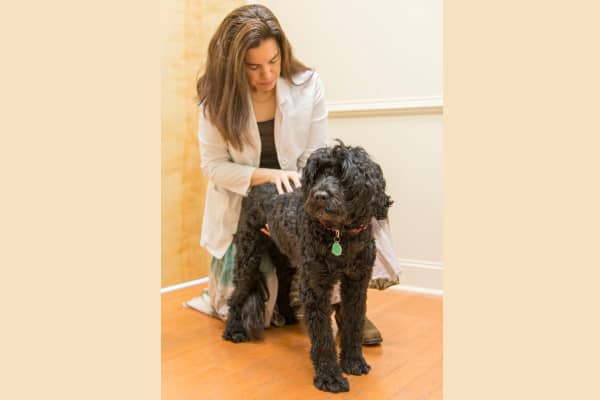
If your senior dog is experiencing back pain, spondylosis is unlikely to be the underlying cause. Anything’s possible, but there’s a laundry list of conditions that I’d be concerned about before pinning the pain on spondylosis.
2. Medications for pain relief
Whatever the root cause, back pain can often be helped with pain medications. Non-steroidal anti-inflammatory medications (NSAIDs) can reduce inflammation in and around the joints. Other medications such as gabapentin for dogs help relieve nerve pain, which is especially helpful if back pain is caused by pressure on the spinal cord or nerve roots.
3. Physical therapy and acupuncture
Veterinary acupuncture for dogs, animal chiropractic, and physical therapy are highly effective methods for mitigating pain and improving mobility for dogs with back pain.
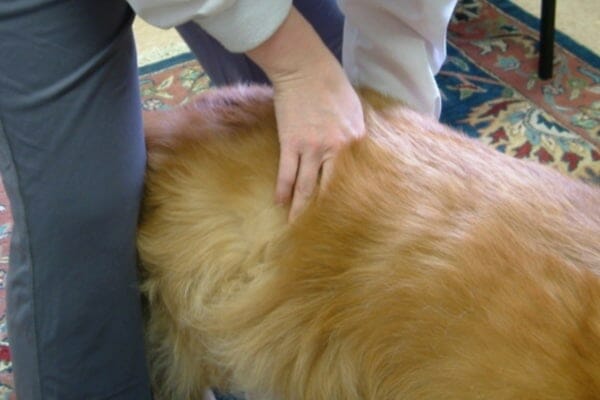
Some veterinary rehabilitation clinics have special tools like underwater treadmills for dogs to help maintain range of motion and muscle mass in dogs with low impact exercise.
4. Weight loss (if indicated)
If your dog is overweight, this is the #1 thing you must address to protect your dog’s spine. Your veterinarian can advise how much weight your dog should lose and can help you formulate a personalized diet plan. Lower calorie foods and controlled exercise can facilitate weight loss.
If you’re unsure whether your dog is overweight, you’ll want to “find your dog’s number” on our canine body condition score chart.
Since present-day pups live longer than their predecessors, they’re more susceptible to joint damage and inflammation over time. Joint inflammation is commonly known as arthritis in dogs. Spondylosis has been likened to arthritis in the spine. However, unlike arthritis, there is not an inflammatory component with the bony changes. This is a blessing because inflammation means hurting.
What is the prognosis for dogs with spondylosis?
Generally speaking, spondylosis itself does not usually impact a dog’s quality of life. Unfortunately, without surgical intervention (which is usually not needed), we cannot reverse spondylosis. Our focus is generally managing spinal health through joint supplements, exercise, and weight control to slow the progression and try to prevent or delay the onset of painful arthritis.
A common disease in senior dogs
Although it is quite common, we generally do not even know that most senior dogs have spondylosis. It is most often diagnosed incidentally, when we take X-rays of the chest or abdomen for a different reason. Because it is not an inflammatory condition, veterinarians generally believe spondylosis deformans is not painful in dogs. However, being aware of symptoms of back pain in dogs can help you identify subtle signs that may indicate your dog has some pain.
Your veterinarian will have your dog’s back on this one (pun fully intended!). Even if your dog’s spondylosis diagnosis is an incidental finding not associated with back problems, ask your vet how you can be more intentional and proactive in maintaining mobility. Your dog will thank you for it!
Has spondylosis affected your senior dog?
Share the subtle signs you first noticed that led you to seek help from your veterinarian. How is your four-legged friend doing today?



My almost 11 y/o boxer was diagnosed with spondylosis in October. X-ray already showed multiple sits of bridging. I am concerned there is more going on. He is on gabapentin and Rimadyl for the pain. His back end sags to almost the floor when he stands or his legs spread out to the sides. This has gotten worse since October. I have also notice that he seems like he cannot find us at times. Lastly, he becomes very anxious in the evenings. Any suggestions would be appreciated.
Hi Daneen,
I understand your concern for your Boxer and think it is good you are searching for advice. Many of the symptoms you describe sound like early stages of dementia/cognitive dysfunction which is very common in senior dogs. I will attach links with more information and options for pain control. Hoping you can find the best way to offer your pup relief. Best wishes to you and your sweet boy.
1. Signs of Dementia in Dogs: Stages, Symptoms & Treatment
2. How to Relieve Arthritis Pain in Dogs: The Ultimate Guide
3. Natural Pain Relief for Dogs: 17 Methods from a Vet
4. Amantadine for Dogs: Everything You Need To Know
5. CBD Oil for Dogs: Facts, Benefits, Concerns [2024]
Hello, thanks for your article. My dog (whippet) is only one year old and has just been diagnosed with spondylosis (routine X-rays to check his legs and because he has slight tremors in the front legs at times). You talk more about old dogs. Given that my puppy might still be growing and things are changing in his body, can I still do something to reverse the deformation or avoid worsening? Vet said it’s probably congenital, and also I know that my puppy had bad nutrition. At 2 months old, he came with rickets (that are gone since).
It’s an energetic breed, so I can’t stop a whippet puppy from running and sprinting.
Thank you
Hi Christine,
I am so sorry your young pup is already developing spondylosis on his spine. While this site is geared toward senior dogs, much of the information pertains to these same diseases and conditions in dogs of any age. The section that discusses treatment options has recommendations that work for any age. Also, the paragraph just below that discusses prognosis holds true for young dogs as well. Ultimately, there is no way to reverse the damage that has already been done, but you can try to slow the progression. Medications, supplements, and therapies that aim to reduce inflammation and strengthen muscles to help stabilize the spine will be your main focus. Hoping you can find what works best for your pup. Wishing you and your sweet boy many happy years ahead.
Hi! Thank you for posting information on spondylitis, I have a 13 year old German shepherd who within a matter of weeks stopped walking altogether. We took him to the vet and they said it was spondylitis, however he doesn’t seem to feel his back legs anymore. They prescribed us Dexamethasone, Gabapentin and Antinol+ however I’ve seen no improvement in him, in fact he’s been doing worse and now can’t even sit himself up so he’s just lying on his side. He also seems to be in a lot of pain but keeps eating and drinking water fine. Are there any recommendations as to other things we can try? Or if it’s even spondylitis?
Hi Paloma,
My heart goes out to you as you face this worrisome situation with your Shepherd. I understand your concern and do think there may be something else going on here. While a bad case of spondylitis is still a possibility, with this breed, I am always suspicious of Degenerative Myelopathy. Here is a link to another article with more information: Degenerative Myelopathy in Dogs: Stages, Symptoms, Care
I highly recommend you talk to your vet about more in-depth testing or even ask about a referral to a specialist if needed. Your boy is lucky to have you advocating for his health and well-being. Praying there is a way to offer him relief and comfort. Bless you both. ♥
Thank you for this information. Our 10 year old mixed breed dog – Lab, shepherd, pit mix has been experiencing regurgitation and vomiting the past year or so off and on.
Most recently over the past week she has continued on a daily basis to regurgitate/vomit her morning meal along with her dinner. Talked to her Veterinarian who prescribed a daily antacid which didn’t seem to make a difference with Continued gastric distress.
(Still very active and alert though having difficulty jumping into the car or bed where in the past she flew through the air like a reindeer.)
In to the Vet’s office we went with blood work and X-rays taken. Blood work for kidney, liver, electrolytes all WNL as well as cancer screen markers. She did lose 8 lbs since her last visit a couple of months ago
70lbs down to 62lbs.
X-ray showed Spondylosis which is causing bloat/ gastric distress. Added a different antacid so we are hoping for the best.
Hi Ann,
I’m glad to hear that your dog’s blood work, X-rays, and cancer screening were normal!
As a point of interest, do you think she is vomiting or regurgitating or both? Typically regurgitation is passive (i.e. no retching or abdominal contractions) and the food is undigested. And vomiting is an active process with retching/heaving and the food may be digested or contain bile. It is helpful to distinguish between them because the causes of vomiting are different than the causes of regurgitation. If it is regurgitation, it may be worth screening for megaesophagus or other esophageal issues if the vet has not already done that. Here is an article on megaesophagus if you want to learn more: Megaesophagus in Dogs: Causes, Symptoms, Treatment
Fingers crossed the new antacid will do the trick so that she can keep food down and get some weight back on (or at least stop losing weight). If it doesn’t, please check back in with your vet!
My Labrador had the same symptoms. Omeprazole, famotidine nothing helped. A gastric bx showed h pylori. Once the h pylori was treated we never had a problem again.
Hi Joanne,
Thats very interesting. Thanks for sharing!
Hi there,
I lost my beautiful Pekingese-Pomeranian mix last week on his 4th birthday. We had to put him to sleep due to severe pain. The veterinarians in Iran told me that he had IVDD disease. The X-ray showed disc herniation between the L2 and L3 vertebrae. The vet prescribed prednisolone but didn’t mention that he must be kept in a cage. My dog was able to walk again, but it got worse. Now I have some questions for you:
About a year and a half ago, my dog fell from a height of one meter on the ground while being held by my friend but there were no issues at that time. After being sterilized about 8 months ago, his weight increased by 1.5 kg. He loved jumping, running, and spinning quickly. For the past few months, he had been rubbing his back against surfaces, which I now realize was due to lower back pain. When I lifted him vertically, he moved his neck from left to right. Twice, I lifted him by his collar fear of attacking other dogs. I don’t know how much this affected his illness. It only took four days from the onset of pain from the paralysis of the hind legs. Now that two weeks have passed since his death, I am despondent and blame myself for what happened to him.
Dear Shahram,
I am sorry for the loss of your young dog. Unfortunately, without having played a personal role in his medical care, it is hard to offer specific conclusions. I am not sure you can blame his injury on one of these incidents. I suspect he was genetically at a higher risk for IVDD and no matter what kinds of activities he took part in, this was likely to happen. I hope with time the grief will fade and your heart can begin to heal. Please don’t let guilt weigh you down. Wishing you comfort and peace as you continue life’s journey.
I just found out my 9 yr old labradoodle has spondylosis. He has always been extremely active but I’ve noticed him slowing down some over the past couple of years. Several months ago I noticed sometimes when he got up for a split second he seemed stiff. Regular check up he thought maybe early signs of arthritis then 2 weeks later one day he had a hard time getting up. Once up no problems. Took him back and vet is very money conscious so said take gabapentin and galliprant. Seemed better but slid in the house and back to hard getting up. Took him today to see vets partner and they did blood work and xrays and found the spondylosis. Blood work was excellent which is good. Gave him more of both meds and Librela injection. I just hope he is able to play some and do some of the things he loves, maybe not huge runs but small running. Makes me so very sad. I’m glad I found this site as it has helped me to have hope that we can manage this and he will feel better and be able to enjoy life.
Hi Juanelle,
I am sorry your senior guy has been living with pain and discomfort. What a blessing your vet was able to make a diagnosis and offer some new treatments to try and make your boy more comfortable. Hoping he responds well to the Librela and can regain his quality of life. Best wishes to you both and keep up the good work!
I adopted a Rottweiler when she was about 6 years old. The next year she started whining after walks so had x-rays done and she had a couple vertebrae fused. She’s been on carpofen for 3 years, so trying something different to prevent ulcers and kidney damage. It worked great, but causes her some GI issues. Hopefully the gallipentin will work just as well.
Hi Kay,
I am sorry your Rottweiler has issues with back pain but am glad you were able to pinpoint the cause. Hoping the Galliprant will offer some relief. Wishing you all the best and keep up the good work!
My 7 year old Rottweiler was just diagnosed with spondylosis. From the X – Ray they also noticed he has an enlarged heart. My VET has given us medications the enlarged heart, and some pain relief but he said that my dogs kidneys were at a level that cannot tolerate the recommended pain meds. There was also some evidence of arthritis but not severe. My Rottie is still mobile but struggles to jump up or do heavy activity. Is there alternative treatments or home things I can do to improve his quality of life. I just know it’s not his time to go yet. It’s definitely not
Hi Naapopye,
I am sorry your Rottweiler is having issues with chronic pain. There are definitely other ways to offer relief other than medications. Supplements can be of great benefit and are generally very safe. There are also alternative therapies you can try such as laser therapy, acupuncture, PEMF, and physical therapy. I will attach links to other articles with more detailed information. Hoping you can find a way to ensure your boy is happy and comfortable. Wishing you all the best of luck for many years to come!
1. Natural Pain Relief for Dogs: 13 Methods
2. Dog Arthritis Treatment: 8 Ways to Help a Senior Dog at Home
3. How to Relieve Arthritis Pain in Dogs: The Ultimate Guide
4. CBD Oil for Dogs: Facts, Benefits, Concerns [2024]
From my understanding, Galliprant doesn’t affect they kidneys. That is what my vet just prescribed my Rottweiler and the carpofen is causing GI issues. Not sure how well it will work yet.
My 10 year old German Shepherd has been diagnosed with spondylosis as an apparent side-effect of reactivity, as in some pain, to abdominal manipulation by two different vets over a 6-month period, although no apparent reason for it. An X-ray pointed out the lumbar bone spurs and an ultrasound showed no other issue to account for the pain reaction. She would happily chase balls and flyers and jump up for them, but for some time she has been unhappy about sitting straight and we had her on carprofen for that. We had been involved in AKC Rally, but have now stopped that. Our assumption is that the abdominal manipulation must bother her muscles. I had tried chiropractic and acupuncture without success. Laser treatments make her feel better, but are only temporary and pretty expensive. She has been on Cosequin for some years and my vet suggested I switch to Dayquin as being stronger. She is also on 7 grams on MYOS daily, which is a muscle supplement. She is a member of the Dog Aging Project (google it) and in the TRIAD test (Test of Rapamycin In Aging Dogs).
Hi Gillian,
I am sorry your senior Shepherd is struggling with back pain. She is very lucky to have you taking such good care of her and advocating for her health and well-being. I have heard of the Dog Aging Project and think it is great your girl is taking part in this and other research. Thank you for sharing your experience. Best wishes to you and yours!
My vet noticed spondylosis in my female samoyed when she was 5. She is now 8 and was showing signs of discomfort-yiping when touched, hesitating before jumping on the bed. I took her in for X-rays. He said it looked like the spine of a 12 yr. He has her on gabapentin, tramadol, and rimadyl. Is that a lot? She loves doing Rally obedience (lots of sits and some downs). And LOVES herding. It breaks my heart to think she can’t do these anymore. What is safe to do with her?
Hi Tana,
I am sorry your girl is having these back issues at such a young age. In general, walking and running shouldn’t cause a big issue but I would recommend discontinuing any high impact activities. I strongly encourage you to find a veterinary rehabilitation professional in your area to partner with. They could be very valuable in helping to keep your dog’s pain and inflammation at a minimum and add years of good quality to her life. Wishing you both the best of luck!
Thank you for your very informative article! I recently went to the vet with concerns that my Boxer Sophie (who ho just turned 3 ) might have pyometra. Luckily it was not pyo but a slight uti. However while looking for pyo in x-ray they found she had severe bridging spondylosis. Most of the literature I have found refers to this as an old dog disease. Can you point me towards information about the disease and treatment of it in young dogs? She is not over weight and is very active running and jumping on our farm. I am spaying her in a couple of weeks as I fear that this could be genetic and I do not want to risk passing this issue on. I have started giving her joint power ( green lipped muscles) and i think she is having an allergic reaction to it as she has now started itching horribly. I just want to find what will help give her the best quality of life.
Hi Dana,
I am sorry Sophie has developed spondylosis at such a young age. I understand your concern and applaud you for taking such a proactive stance in searching for answers. I am not aware of any differences in treatment for this condition that would vairy with age of onset. To my knowledge, the presence of spondylosis is always due to joint instability. I would recommend you find a good joint supplement that she tolerates and doesn’t cause an allergic reaction. Also, this would be a good time to team up with a veterinary rehabilitation professional. They can follow Sophie’s condition as she advances in age and give you exercise and therapy recommendations to offer the most benefit at each stage of life. Wishing you both all the best. Give your sweet girl a hug for me and keep up the good work!
Hi Dr Buzby,
My incredible boy Spook, Spook the Great Dane, Life Matters Suicide Prevention Ambassador. https://www.facebook.com/profile.php?id=100083023166622
Has just today been diagnosed with Spondylosis via x-ray. You information has really helped me understand what we are dealing with.
Thank you.
Colleen
Hi Colleen,
Spook seems like such an amazing boy! Thank you for the positive feedback about the article. Hoping you can find the best way to keep your big guy pain free. Best wishes!
My 15 year old shih has just been diagnosed with spondylosis after a routine exam as I said his back legs are started to drop and he occasionally loses his balance. My dog is fine atm , eating fine and running round after his toy. The vet has prescribed Tralieve 20mg, onsior 10mg and gabapentin 50mg is this a lot of drugs ?
Hi Jennifer,
I understand your concern for your senior pup and these medications he has been prescribed. Since I have not personally been a part of your dog’s medical care, I can’t make specific conclusions about his medication regimen or dosages. I can say that when dealing with severe pain my own patients, I have prescribed these exact medications in combination with each other with great success. How is your boy feeling today? Hoping all is well and wishing you the best.
Hello and thank you for sharing this information on spondylosis. My 14 yr ShihTzu who has Cushing’s started having some stability issues about 3 months ago. In the last few weeks it has gotten progressively worse. Our vet did some x-rays and found she has spondylosis. It has severely affected her mobility. Prednisone was given and we are hoping this will offer some improvement. She does not appear to be in pain. but her activity level, appetite and overall demeanor has gone down. Due to her age, we are not in favor of any surgery. Would be interested to hear your thoughts.
Hi KC,
I am sorry your senior pup is struggling with mobility issues. This is a very common issue in senior dogs and luckily there are many treatment options! There are several pain medications that can be used that don’t have the same side effects as can be seen with prednisone. You can discuss these options with your vet and can make a decision about which is best to use long term. Also, I highly recommend you talk with a holistic vet or one that practices alternative medicine. A veterinary rehabilitation professional could also be of great service in this case! Things to consider include acupuncture, PEMF, supplements (like Encore Mobility) or herbs, physical therapy, laser therapy, etc. Here is a link to another article with more information: Natural Pain Relief for Dogs: 13 Methods
Best wishes and good luck!
Our 12 year old Shih Tzu, Leo, was just diagnosed today. We started noticing he was having trouble going down steps and when he fell down the last three stairs, we began to carry him. Then we noticed he was walking like his joints weren’t connected at the hip or knees, his trot was wobbly and he would tilt when standing still. Next came knuckling where he was dragging his right foot. When we took him in for rabies vaccine, we asked them to watch him walk and they gave us joint supplements. Finally, when he couldn’t get up on the first step because his back legs couldn’t lift him, and he could barely hold himself off the ground to go poop, we decided it was more than just joints. Today, the x-rays showed bone spurs and the vet said his brain didn’t tell him his foot was upside down. Prednisone was prescribed and hopefully, he will improve.
Hi Jan,
I am sorry your little guy is having mobility issues and struggling with arthritis. I am glad your vet was able to get some answers and start treatment with the prednisone. I hope you will see a big improvement in your dog’s comfort level with this medication. Don’t forget you can always talk to a neurologist if you need more information or therapy options. Here is a link to an article with additional info on prednisone: Prednisone for Dogs: 10 FAQs Answered
Best wishes for healing and many happy days ahead.
My boy Shiloh may have this. I spoke to the Vet Assistant this morning and was told there was bridging along his spinal column. Right now my 100 lb German Shepherd mix cannot walk by himself. He’s just laying on his bed waiting till I can get him in to his appointment tomorrow morning.
The Vet Assistant indicated that he may need to be put down. I’m devastated and my wife is in bed crying her eyes out. Is there any hope for Shiloh?
Hi Scott,
I am so sorry Shiloh is struggling and in such bad shape. I hope the appointment at your vet this morning was helpful and addressed your concerns. It might be a good idea to have a consult with a veterinary neurologist. I am not used to seeing spondylosis cause a complete loss of mobility in dogs, although I guess it is possible. What did you find out? Feel free to leave an update if you have time. Praying Shiloh is ok and that you will be able to find a treatment to restore his quality of life. ♥
Jackson is a very large Husky/GSD. He slipped and fell on a wet deck while racing around a corner and fractured his pelvis about 1 1/2 years ago. That happened right after his second ACL surgery. While recovering from that, about 6 months later, he was diagnosed with spondylosis when he started carrying his hind right leg. He was put on Galliprant once a day and 300 mg gabapentin twice a day. He also started cold laser therapy once a week. His limp never completely goes away but gets a little better at times,depending on his activity. He mostly lies down all day, and has gained weight, his vet recommending I limit his food now. I just ordered a bottle of your Encore Mobility. I am going to start using heat and massage on him. Would muscle relaxants help? Is there anything else I can do? Would a consult with a veterinary neurologist be helpful?
Hi Ellen,
I am sorry your big guy is having so many issues with arthritis pain. It sounds like you are doing a great job keeping up with his treatments and advocating for his wellbeing. If your boy is overweight, then weight loss will be the biggest game changer for his situation. Studies have shown that weight loss can do more to reduce pain levels associated with osteoarthritis than even prescribing opioids. With that being said, it is never a bad idea to have him evaluated by a neurologist. They may have ideas about therapies that are not commonly used in general practice. Maybe acupuncture would be worth a try? I hope you can find the answers you need to give your sweet boy the best quality of life. Let me know what you think about the Encore Mobility after he has been taking it for a few weeks! Best wishes to you both.
My 5yr old blue cattle x staffy has just had his first “bridge” show up on an xray on his last lumbar vertebrae. He showed signs of acute pain (not jumping up on to the couch /bed / car etc & getting stuck and whimpering when weight was on hind legs while trying to climb up) at easter and was given a course of non steroidal anti inflammatories. This eased his pain significantly & he was no longer whimpering and back to jumping up on the couch etc. However as the weeks passed I noticed that Hank no longer jumps to catch a ball with all 4 legs off the ground (previously he would jump up to 4ft into the air and sometimes flip if the ball bounced high enough) he also no longer gives hugs when I come home, he won’t spend more than 3 sec on his hind legs instead he sits and waits for pats (good behaviour but not typical for him). Took Hank to the vet today & she noticed that his hips were a bit stiff for a dig his age took an xray & here we are. Im so fortunate to have a patient & pro active vet. We now have answers & know how to manage Hank’s comfort levels & I know what what activities to avoid so we don’t aggravate his spine. Alway trust your instincts when it comes to “minor” behaviour changes in your pets.
Hi Melinda,
I am so glad you have such an amazing partnership with your veterinarian. Hank is lucky to have the both of you advocating for his health and wellbeing. I am glad you received a positive prognosis and have a treatment plan in place to keep him comfortable and active. Wishing you both the best for many happy years to come.
My female 13 year old cocker spaniel has an enlarged heart and is being treated for that. Her spine down her back and tail are very visible from the outside looking at her. She shakes when having a bowel movement and whimpers . She falls easily and doesn’t jump up to get on the furniture anymore. I’m going to call for a vet appointment tomorrow but I am wondering if you’ve ever saw these symptoms before?
Hi Melissa,
I am glad you are planning to have your senior girl examined by your vet. Unfortunately, yes, these symptoms are all too common in senior dogs. Most are related to arthritis and loss of lean muscle mass. A neurological issue could also play a role which is why an exam is so important. I am hopeful that your vet will be able to find a treatment to relieve your girl’s pain and help restore her quality of life. Wishing you both the best and good luck!
My 3.5 year old Scott’s American Bulldog and APBT mix was just diagnosed with relatively severe lumbar spondylosis yesterday.
She’s been taking joint supplements for the last 2 years because I thought she had bad hips, which helped significantly with any signs of pain or discomfort she had been having.
She was morbidly obese at 120lbs before she was a year old from her previous owner that fed her bacon grease everyday. She is now 74lbs.
She was just started on an anti inflammatory medication to see if there is a change in her mobility. We are working closely with our new vet to decide our next steps.
I’m so happy I was able to find this article to learn a bit more about what is going on with her. It has also helped to ease my nerves. Knowing she can continue on with a relatively normal life.
Hi Hunter,
I am glad to hear you have a good partnership with your vet and are working toward a solution for your sweet girl. Thank you for sharing your story with our readers. It puts a smile on my face to know the article has been helpful for you and has eased your worries. I hope the new medication will be a game changer for your pup and allow her to live her life to the fullest. She is lucky to have you in her life and act as her advocate. Wishing you both many happy years together in the future!
My 13.5 year old German Shepard boxer boy was diagnosed with this about 2-3years ago and has been receiving steroid shots every month for about a year.. I am seeing him get stiffer and harder to walk. I noticed his back looking crooked when he walks. He needs assistance into the truck. He is also taking Tramadol 150mg . My beagle recently passed and I’m seeing my GS declining more. I am concerned he is in a lot of pain and the meds aren’t helping as much. Last night he wouldn’t take the meds. ( I wrapped them in turkey slices) Do I still keep finding therapies or do I look at saying goodbye? I do not want him to suffer in pain— but if there’s something that can help him more than the steroid shot and tramadol….
Hi Sandra,
I am sorry your Shepherd boy is struggling with back pain. I applaud you for advocating for him and being sensitive to his quality of life. I recommend you talk to a veterinary rehabilitation specialist or integrative vet in your area. They may be able to offer different treatment options such as laser therapy, different supplements, acupuncture, or even chiropractic adjustments. Also, make sure your vet knows the current medications don’t seem to be helping as much anymore. There are many pain medications and anti-inflammatory choices that can be tried and even added on to your dog’s current medications. With all that being said, you know your pup better than anyone and if you think it might be time to let go, it is always better to say goodbye one day too early rather than one day too late. I hope you can find the answers you need to make the best decision for you and your sweet boy. Wishing you the best as you navigate this difficult path.
Thank you for this article. My son’s 15 y.o. Lab mix suddenly couldn’t jump up on our bed and then refused to try after 2 failed attempts. He also refused extra chances to go out during the day which was not like him and when he did go out, he didn’t even try to chase the squirrels. We took him in and had a full blood panel and x-rays done since since the physical exam didn’t show anything other than a minor pain response to abdominal palpitations. All tests came back excellent, but the doctor found he had 2 of these bony bridges. He just got his first doses of Gabapentin and rimadyl. We are just hoping it helps.
Hi Lori,
I am so glad you had your son’s dog examined by your vet and they were able to make a diagnosis. I pray the pain medications will help and allow him to continue living his best life. You may also want to consider talking to an integrative veterinarian or one that specializes in rehabilitation. They might have access to different treatments or supplements that could make a big difference for your dog. Good luck and wishing you both the best!
Hello Dr. Julie,
My 13 yrs old rescued female dog is currently suffering from spondylosis, but why is even more serious is that she suffers from pancreatitis too.. the things that wouldn’t allow me to give her many medications; supplements or pain killers…
I tried canydril and she was in Swedish pain in the stomach that I couldn’t go on with it…
She is currently receiving two doses of gaptin 300 per day .. at the beginning it stopped the pain, but seems by time things get worse and that was why I tried canydril but it gave her horrible pain (though is is a non steroid medicine)
I am currently so confused and feeing awe full I can’t help her with her pain…
Any suggestions please for some medicine who would help with spondylosis and still be easily digested with a dog with pancreatitis?
Appreciate your reply…
Many thanks,
Nermine.
Hi Nermine,
I am sorry your dog is suffering and painful. I can hear the concern and worry in your words you typed. I recommend you contact a holistic or integrative veterinarian in your area, as they have access to many herbal supplements that could benefit your girl. Also, a vet that practices rehabilitation and physical therapy has many options to help reduce pain and inflammation without medications such as: laser therapy, acupuncture, chiropractic adjustments, massage, etc. I hope you can find a treatment that will give your dog back her quality of life. My thoughts are with you as you navigate this difficult journey.
Thank you Doctor for your warm reply… I just contacted a place where they offer physiotherapy for dogs and will be in touch with the vet soon… there are not too many places here that offer such services.. but hopefully that place can help.. I just lost 2 seniors last July with similar cases but with no pancreatitis so I was able to give proper medication… but my girl’s case is a bit more complicated as you see.. spondylosis is even causing her urinary incontinence…… I will try to find a holistic place who can help though I am in doubt I ll be able to find that..
anyways, many thanks again for your prompt reply and concern.. ❤️
Hi Nermine,
Do you mind me asking how your girl went with physiotherapy treatment rather than medication? My 5 year old boxer has just been diagnosed with quite severe spondylosis but he also has a history of pancreatitis. He’s been fairly asymptomatic but has historically demonstrated that he has a high pain threshold. I’m specifically interested in your case as your girl suffers from both conditions, same as my boy. If you see this, I’d be so grateful to hear from you.
My 12 year old corgi, Atlas first started showing signs around April/May of this year 2021), mostly having a more drunken walk. Got her x-rayed and it showed she has 4 bony spurs along her lower vertebrae that are close to fusing. We got her started on Gallaprant, giving her massages and at home PT in hopes to help keep muscle retention in her rear legs as well as acupuncture. Over the next several months it slowly got worse, she now drags her right hind quarter and is slowly starting to lose strength in her left hind quarter. She is still such a happy dog, and doesn’t seem to notice her disabilities which is good. See what the future hold. We may end up getting an MRI to see if there is anything else that might be contributing to all of this.
Hi Cassidy,
Thank you for reaching out to me about Atlas. I feel like you are correct in thinking there may be something else going on. It is rare for spondylosis to cause symptoms, and when it does, it is usually a stiff back instead of a drunken gait. I am suspicious there may be something neurological happening with Atlas. Here is a link to another article that may provide some insight: Are Your Dear Old Dog’s Back Legs Collapsing? 6 Reasons Why Since I have not examined her myself, I can’t make any specific recommendations. It would be a good idea to update your vet on these new symptoms. You may also want to seek out the services of a local veterinary neurologist. I hope you can get some answers to what is causing your sweet girl to struggle so much. Best wishes to you both and keep us updated!
I adopted a mixed breed dog that I learned through DNA testing was half pomeranian and half Jack Russell who was the love of my life that was always a very healthy dog with a weight issue as he loved to eat but hated to move. None of my other dogs had a weight issue. He was diagnosed with a heart murmur at around age 8 and started daily medication for it at around age 12 where I was warned it would extend his life “another 14 months” beyond his normal lifespan. I was so focused on his heart health that I didnt focus on fact he was walking with much stiffer gait over a period of just a few weeks and was arching his back and having difficulty defecating. It still looked like just the aches and pains of old age that my other senior dogs were already experiencing so I just took him on shorter walks and changed his diet. Then everything came crashing down after less than two weeks in this condition he coudlnt walk at all but wasnt paralyzed so I rushed him to vet and he was diagnosed with this condition and I was sent home with morphine and told to keep giving him his regular meds. The first two days on morphine worked great but on third day he was still paralyzed from back down and thrashing about I put him to bed next to me that night and he died in his sleep.
I realize now that he was SIXTEEN years old so I think he didnt want to fight this and was just ready to let himself go. And more importantly he didnt want to be in pain. So I have come to terms with it but wanted to warn everyone if your dog shows any signs of this disease move quickly to see a vet and act on it otherwise it can escalate very quickly.
I also realized as proud dog parent that for a dog it is quality of life that matters most not quantity so while it would have been nice for me to have him around at least a little longer that wouldnt have been fair to him. And it had to be all about him and not me.
Hi Tony,
So sorry for the loss of your dear dog. It is always difficult to lose a beloved companion. Thanks for sharing his story, both to remember him and to help other dog parents in a similar situation. It sounds like you took great care of him and I agree completely that quality, not quantity, of life should be the focus. I hope that the wonderful memories you made together over the years can help bring some comfort in this difficult time. ❤
Our 13 year old GSD started having issues with her forelegs in winter about 3 years ago. (limping when walking outdoors, then licking when inside). We changed her food to healthy mobility, and added a glucosamine supplement. This seemed to clear that up. About 2 years ago, we noticed a limp on the right rear. At one point, she refused to stand. The vet diagnosed hip dysplasia, and prescribed meloxicam. The effects were almost miraculous. This spring, March 2021, we noticed that she was stumbling in the back legs, with a wild swing in her hips. The toenails on her back feet were almost worn completely off. The vet took one of her hind feet and set it down upside down, and Gracie didn’t correct it. This indicated to the vet that there were spinal issues. Gabapentin was prescribed. This seems to really help the stumbling, and the hip sway went away. We also worked on her weight, taking off about 5 lbs – to what her vet says is a perfect weight. Last week, she started passing blood in her urine, and the stumbling became worse (even weak on the front legs), so we became concerned that possibly there may be a cancer at work. We also wanted to KNOW if there was anything we could do, treatment-wise – maybe spinal fusion. So, a urine test and several x-rays later we know she has a UTI, and bridging spondylosis – on every vertebra in her spine. The hip dysplasia is not bad at all in the right side, and there is none on the left. Now we know. We will treat the UTI and see if that was causing the weakness, She still eats well, is playful, sometimes runs, loves hanging around with us. The next, and possibly final, step will be prednisone.
Hi Janet,
Thanks for sharing your pup’s story. Sorry to hear that she has been facing so many mobility issues over the past few years and has recently been diagnosed with a UTI and bridging spondylosis. Hopefully the UTI clears up soon and was the culprit for the increased weakness. And if not, I hope you are able to find a combination of medications and therapies that will help her maintain as much mobility as possible. She would also be a good candidate for ToeGrips because they could help her get a better grip on slippery surfaces and also protect her nails from wearing down quite so much. If she is dragging her feet, you would want to apply the ToeGrips with superglue to keep them from getting tugged off. The instructions are in this video: How to apply ToeGrips with glue. Best of luck to you and your sweet pup!
Help!!! On Saturday I left my 12 y/o pit bull here in the house for 1 1/2 he was fine. When I returned he was “broke down in his back end.” He can’t put weight on his back legs. I have Tramadol for my back pain and started him on it 3 times a day. On Monday he was seen by our vet who diagnosed him with Spondylosis, gave him Carprofen 1xdaily & said there is nothing else she can do. Today, Thursday he is worse….dragging his back legs like he has no control of them. Sunday he seemed better with the Tramadol. He was able to bare some weight and walk, wanting to go outside and play with his ball. This morning it is heartbreaking to watch him falling down and drag his back legs. Is there anything else we can do? Will he ever be able to walk somewhat normal? The thought of putting him down is unbearable to me. Is there any hope?
Hi Cathy,
So sorry to hear about your pup’s sudden issues with his back legs. It is so heartbreaking to watch a beloved dog struggle like that. Without being able to examine him and see the X-rays, I can’t say for sure what the outlook will be for him or what the best therapies would be. However, I can tell you that there are a multitude of different management options that could potentially be helpful such as laser therapy, acupuncture, rehabilitation therapy, or some medication modifications. Since it seems like he is worse this morning, I would recommend trying to get a second opinion, either from a different general practice vet or a specialty (neuro, ortho or rehab) vet. This isn’t in any way to say that your current vet didn’t do a good job or was wrong. It is just a matter of different vets having access to different tools in their treatment toolbox. I hope you are able to find some answers and solutions for your sweet boy!
My 6 year old female pug all of a sudden couldn’t stand up and could barely walk . I thought she had a stroke . I took her to my vet and they kept her over night for observation. They said she had an arthritic bulge on her lower spine that was causing the issue. They put her on Gabapentin carprophen and a once a day chewable for healthy joint repair . They had also gave her a lazer treatment and recommended 5 more treatments . I take her out every 2 to 3 hours during the day to go potty she is able to stumble around and pee and poo on her own but she is carried everywhere else Sje sleeps solid thru out the night She has never acted like she was on any pain and has never cried when picking her up she just acts confused and looks sad Which is heartbreaking because she is normally a happy and loving girl to everyone Its been 2 weeks now and I don’t see any improvement Is there anything else that I can do for her?
Hi Carina,
So sorry to hear about your pug’s difficulty walking and standing. That would be quite heartbreaking to watch. It sounds like your vet did a great job coming up with the initial plan but your dog unfortunately hasn’t responded to it as well as expected. Since it has been two weeks with no improvement, I would recommend either making an appointment with your vet for a recheck or considering an appointment with a veterinary neurologist. Sometimes it can be beneficial to enlist the help of a specialist such as a veterinary neurologist in the cases that aren’t progressing as expected since they have the ability to do advanced diagnostics (MRI, CT, etc) that a general practice vet doesn’t have access too and also have the benefit of seeing a huge number of cases like your dog’s. Best of luck to you and your pup!
Help, my 10 yr old OES has spondylosis, living on carprophen, cant control her BM, or walk stairs is there any hope. Vet suggested stem cell therapy.
Hi Judy,
So sorry to hear that your OES is struggling with spondylosis. I don’t have any personal experience with stem cell therapy for any of my patients and overall it tends to be one of those therapies that sometimes but not always has good results and requires careful patient selection. It is possible that your pup might benefit from the addition of a second pain medication such as gabapentin or tramadol, so this is something you could ask your vet about. I would also recommend starting her on a joint supplement such as Encore Mobility and looking into rehabilitation therapy (doggie PT), acupuncture, chiropractic, or laser therapy as additional ways to reduce pain, maintain mobility and support her overall health. I hope you are able to find a combination of things that can help your sweet pup feel and move a bit better.❤
My dog golden retriever 8 years ,2 weeks ago she can’t walk on her 2 back leg i went to the vet and told that she has spondylosis and gave her medicine but till now i didn’t see any progress
The therapy can help her ????
Hi Sylvie,
Sorry to hear that your golden is having difficulty walking on her rear legs. Since you haven’t seen her make any progress so far I would recommend doing a recheck with your vet and/or asking your vet if he or she thinks it might be beneficial for your dog to have an appointment with a specialist (rehab, orthopedics, or maybe neurology). There are a wide array of different therapies that can be beneficial, but there isn’t necessarily a “one size fits all” plan. Some dogs respond better to certain things than others (acupuncture, chiropractic, laser therapy, different pain meds, joint supplements, physical therapy, surgery, etc). I hope you are able to find a combination of things that will help your pup!